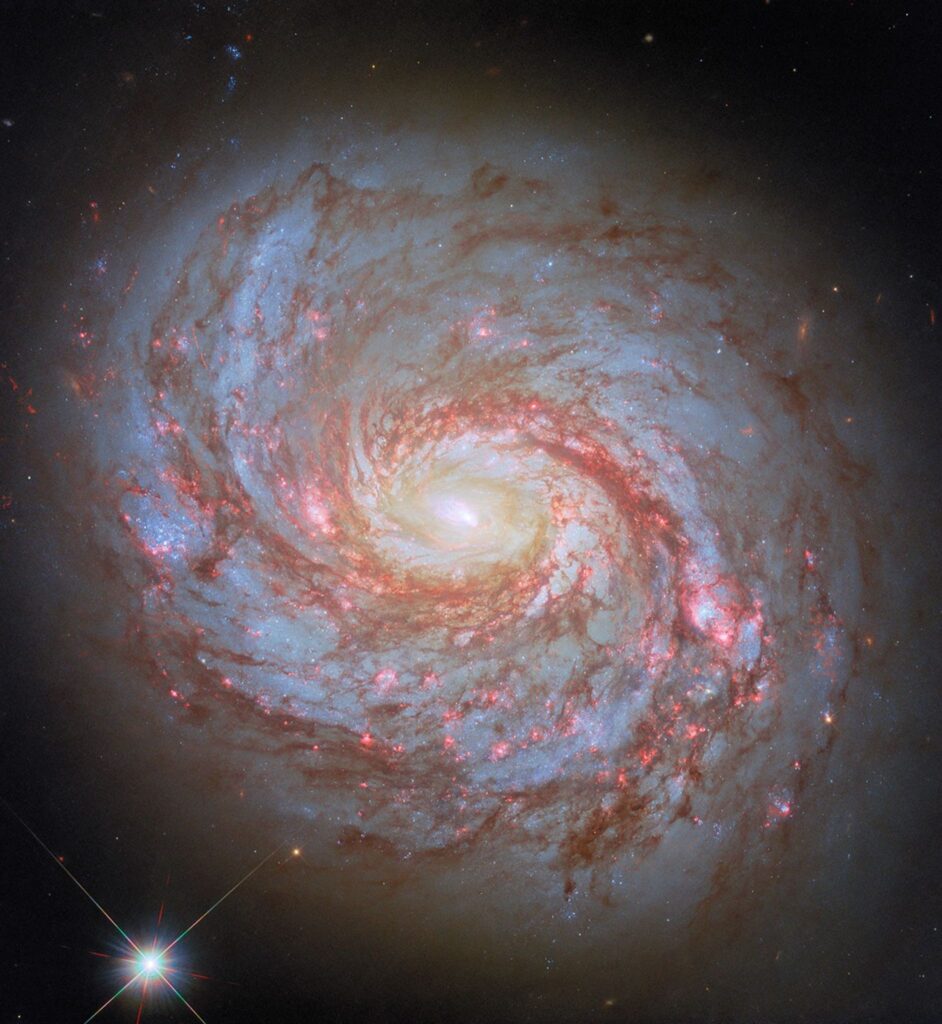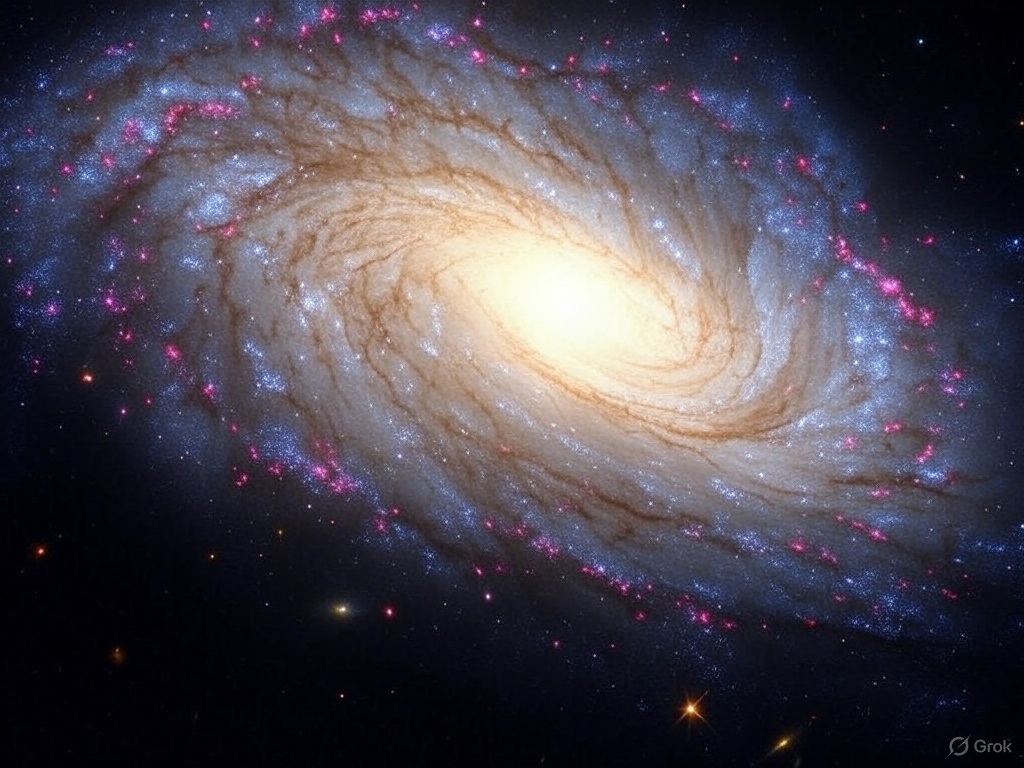
Introduction
- The universe is an ocean of cosmic wonders, filled with islands of stars we call galaxies.
- Sometimes, the names we give these distant formations evoke surprisingly terrestrial, even aquatic, imagery.
- Today, we plunge into the celestial depths to explore one such marvel: Messier 77, famously nicknamed the Squid Galaxy, brought into stunning new focus by the keen eye of the NASA/ESA Hubble Space Telescope.
- Residing 45 million light-years away in the constellation Cetus (The Whale), this galaxy offers a captivating blend of visual beauty, historical significance, and astrophysical intrigue.
An Ocean Away: Locating the Squid Galaxy
- Imagine casting a net into the cosmic sea. Your target lies within the celestial borders of Cetus, the Whale – a fitting home for our aquatic-themed galaxy.
- Messier 77, or NGC 1068 as it’s also known in the New General Catalogue, isn’t just a faint smudge; it’s one of the largest galaxies in the Messier catalog.
- Its distance, 45 million light-years, is staggering. Light captured by Hubble today began its journey towards Earth when our planet was deep in the Cenozoic Era, long before modern humans walked the Earth.
- This immense distance underscores the vast scale of the universe and the power of telescopes like Hubble to bridge these cosmic gulfs.
- The Squid Galaxy itself is a majestic barred spiral galaxy, oriented nearly face-on towards us, allowing astronomers a relatively clear view of its intricate structure.
- Its bright, dominant central bulge and well-defined spiral arms swirling outwards make it a classic example of its type.
- But it’s the more subtle, recently highlighted features that truly live up to its intriguing nickname.
From Comet Imposter to Island Universe: A Historical Perspective
- The story of the Squid Galaxy begins not with squid or whales, but with comets. In 1780, French astronomer Pierre Méchain, a collaborator of the more famous Charles Messier, first spotted this object.
- Both astronomers were primarily comet hunters. In the late 18th century, telescopes were improving, but distinguishing faint, fuzzy deep-sky objects from the transient comets they sought was challenging.
- Comets were celestial prizes, often bearing the discoverer’s name, while these other fuzzy patches were often seen as nuisances.
- To aid in this hunt and prevent rediscovering known non-cometary objects, Messier began compiling his famous catalog of “nebulae and star clusters.”
- Messier 77 was the 77th entry. At the time, through the relatively small telescopes available to Messier and Méchain, M77 appeared as an intensely bright core surrounded by a hazy, nebulous cloud.
- They logically, but incorrectly, classified it as either a star cluster wreathed in gas or a “spiral nebula.”
- This mischaracterization wasn’t unique to M77. For over a century, the true nature of these “spiral nebulae” remained a subject of intense debate.
- Were they swirling clouds of gas within our own Milky Way galaxy, perhaps nascent solar systems in formation? Or were they, as some suspected, incredibly distant “island universes” – entire galaxies comparable in size and scope to our own? The appearance of objects like the Squid Galaxy through early instruments, resembling known nebulae or unresolved star clusters, fueled the argument for them being relatively local phenomena.
- The resolution came in the early 20th century, solidified by the work of astronomers like Vesto Slipher, Henrietta Leavitt, and Edwin Hubble (after whom the space telescope is named).
- Hubble’s observations of Cepheid variable stars in the Andromeda Nebula (M31) definitively proved its immense distance, establishing it as a separate galaxy.
- This discovery revolutionized cosmology, expanding our conception of the universe from a single galaxy to one populated by billions. Messier 77, once a fuzzy patch mistaken for a comet or a local nebula, was finally understood to be a magnificent galaxy in its own right – a fellow “island universe” far beyond the Milky Way’s shores.
Earning its Tentacles: The Modern “Squid Galaxy”
- While its Messier designation is historic, the name “Squid Galaxy” is a much more recent, descriptive moniker. It doesn’t refer to the main spiral structure visible even in amateur telescopes, but rather to more subtle, extended features revealed by powerful modern instruments and advanced imaging techniques.
- Faint, filamentary structures, possibly tidal tails or extended streams of gas and dust, appear to curl around the galaxy’s main disk, evoking the image of a squid’s tentacles wrapping around its body.
- These delicate features are often the result of past gravitational interactions with other galaxies or outflows driven by processes within the galaxy itself. Their discovery highlights how our perception and even our naming of astronomical objects evolve directly with technological progress.
- What appeared as a simple fuzzy patch to Messier and Méchain unfolds into a complex system with intricate, evocative details when viewed through the likes of the Hubble Space Telescope.
- The Squid Galaxy serves as a perfect illustration: scientific understanding and technological capability literally change how we see, and what we call, the universe.
A Galaxy with a Hidden Engine: The Active Heart of M77

- Beyond its visual appeal and historical context, the Squid Galaxy holds immense scientific interest due to what lies hidden at its core.
- Messier 77 is one of the nearest and brightest examples of a Seyfert galaxy – a class of galaxies characterized by extremely luminous Active Galactic Nuclei (AGN).
- At the heart of M77 lurks a supermassive black hole, estimated to be about 15 million times the mass of our Sun.
- This cosmic behemoth isn’t dormant; it’s actively accreting material – gas, dust, and even unfortunate stars – from its surroundings.
- As this matter spirals inwards, it forms an accretion disk, heating up to millions of degrees due to friction and intense gravitational forces.
- This process releases tremendous amounts of energy across the entire electromagnetic spectrum, from radio waves to X-rays, making the galactic center outshine the combined light of billions of stars in the host galaxy’s disk.
- Messier 77 is specifically classified as a Type II Seyfert galaxy. In the unified model of AGN, the central engine is surrounded by a thick, doughnut-shaped torus of dust and gas.
- Our viewing angle relative to this torus determines the AGN type we observe. In Type II Seyferts like M77, our line of sight is obscured by the torus. We don’t see the broad emission lines from the innermost regions of the accretion disk directly in visible light; they are blocked by the dust.
- However, the torus itself absorbs the intense radiation from the center and re-emits it at longer wavelengths, particularly in the infrared. Furthermore, high-energy radiation like X-rays can penetrate the torus, and outflows perpendicular to the disk can interact with surrounding gas, creating observable phenomena.
- Studying the Squid Galaxy allows astronomers to probe the physics of AGN, understand the interplay between a supermassive black hole and its host galaxy (known as feedback), and investigate how these energetic cores influence galaxy evolution, potentially regulating star formation within the galactic disk.
- Its proximity makes it a prime laboratory for testing models of AGN structure and behaviour.
Hubble’s Renewed Vision: Seeing the Squid Anew
The Hubble Space Telescope has observed Messier 77 before, with a notable image released back in 2013. However, the latest image, which sparked this discussion, represents a significant upgrade. It incorporates more recent observational data captured using different, potentially more sensitive or specific, filters. Crucially, it also benefits from updated image processing techniques developed over the past decade.
These advancements allow astronomers to:
- Resolve Finer Details: Tease out more intricate structures within the spiral arms, dust lanes, and star-forming regions.
- Enhance Color and Contrast: Better differentiate between various stellar populations (young, blue stars vs. older, redder stars), glowing gas clouds (HII regions), and obscuring dust.
- Reveal Fainter Features: Potentially bring out the subtle “tentacle” structures that give the Squid Galaxy its name with greater clarity, or reveal other faint streams and shells resulting from past interactions.
- Provide Multi-Wavelength Context: While Hubble primarily observes in visible, ultraviolet, and near-infrared light, combining data from different filters provides quasi-spectral information, helping to understand the physical processes occurring within the galaxy.
Revisiting well-studied objects like the Squid Galaxy with improved technology is a cornerstone of astronomical progress. Each new look, leveraging better instruments or refined processing, can reveal previously unseen details, challenge existing models, and open new avenues for research. Hubble, orbiting above Earth’s blurring atmosphere, continues to be an invaluable tool in this ongoing exploration, providing unparalleled sharpness and depth in its cosmic portraits.
A Cosmic Cephalopod Worth Studying
The Squid Galaxy, Messier 77, is far more than just a pretty picture or a historical footnote. It is a dynamic system offering insights into:
- Galaxy Evolution: How spiral galaxies form and evolve their structure.
- Active Galactic Nuclei: The physics of supermassive black holes and their accretion processes.
- Star Formation: The conditions triggering bursts of star birth within galactic arms.
- Cosmic Distance Scale: Its role as a relatively nearby major galaxy helps calibrate distance measurement techniques.
- Astronomical History: Its journey from a mistaken nebula to a key example of an active galaxy mirrors the evolution of our understanding of the universe.
From the comet hunters of the 18th century mistaking it for a local cloud, to modern astrophysicists probing its energetic heart and faint outer tendrils, the Squid Galaxy has captivated observers for centuries. The latest Hubble image serves as a potent reminder that the universe is constantly revealing new layers of complexity and beauty, especially when viewed through our most powerful technological eyes. As we gaze upon this celestial cephalopod swimming through the constellation of the Whale, we are reminded of the vast, dynamic, and endlessly fascinating cosmos we inhabit, and the ongoing human quest to understand our place within it.